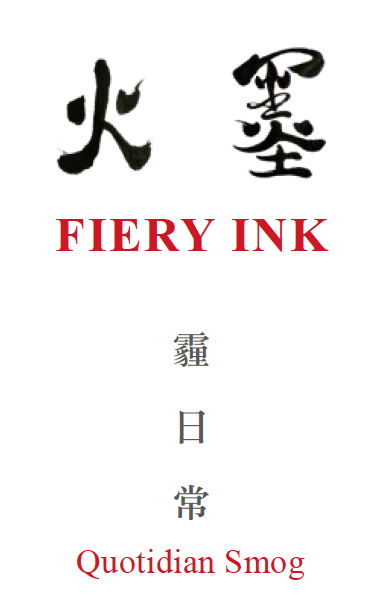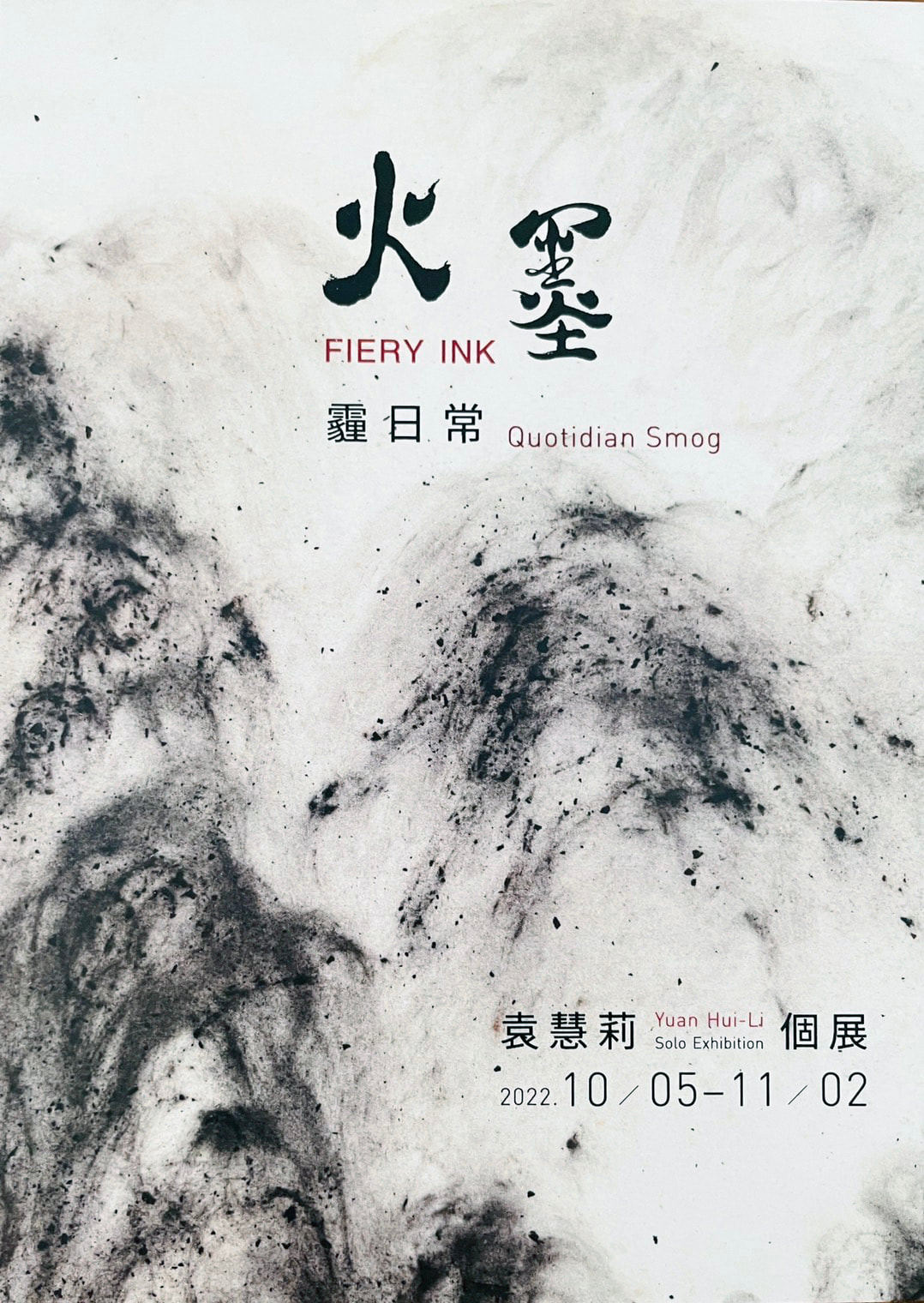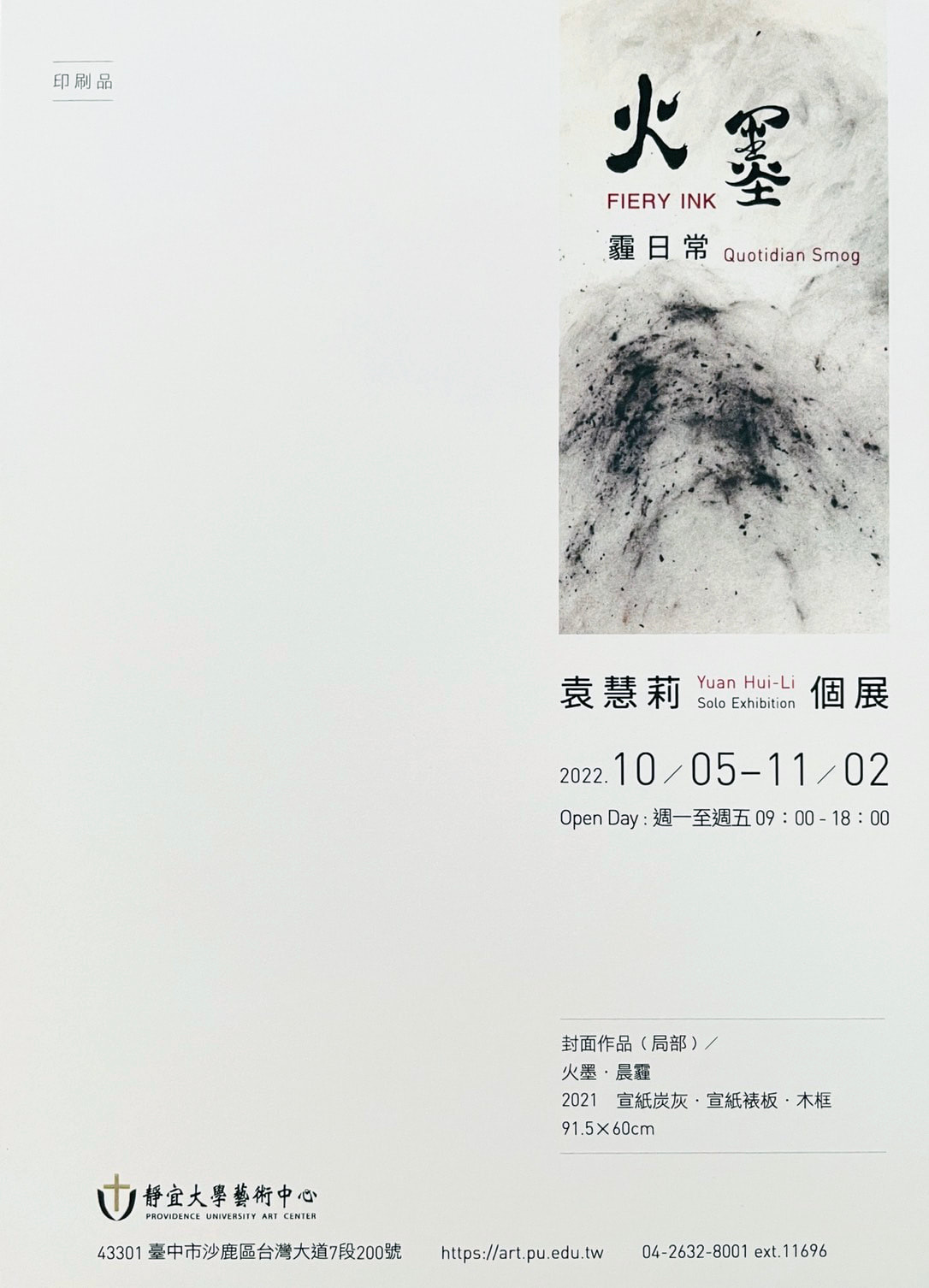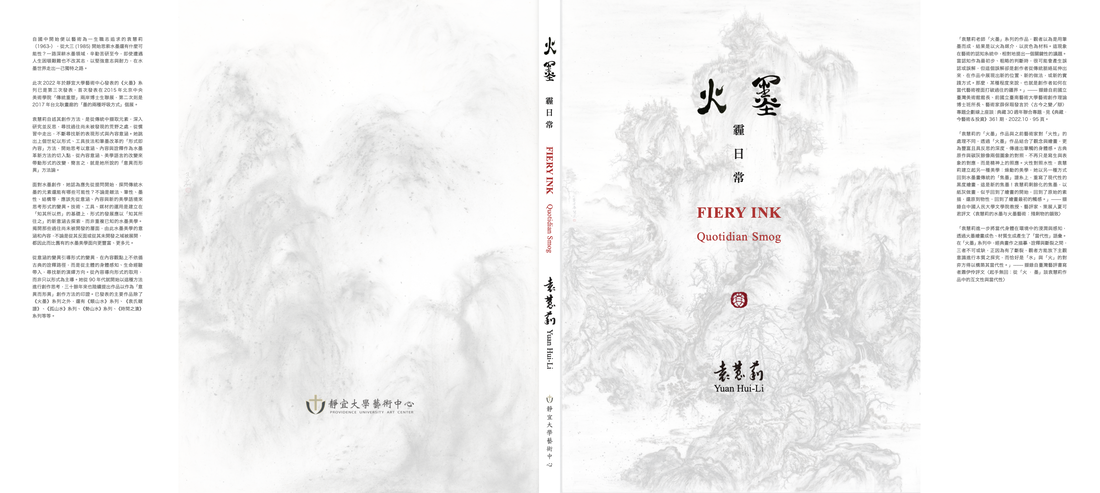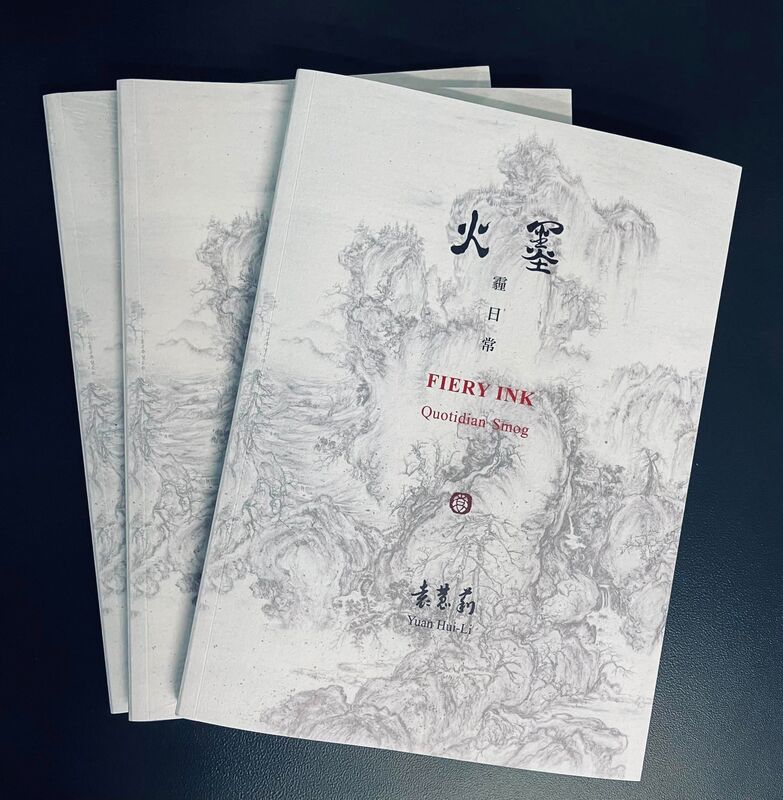展覽簡介
地球暖化導致氣候變異,乾旱、野火焚山、空汙、沙塵暴等景觀,成為地球各國常見生態災難。古來山水畫向以表現「可居可遊」的理想山川為追求,然而,當代真實世界已發生了變異,山林也難逃全球空汙、災變的影響,我不想依舊躲藏在那自以為仍然理想的桃花源幻想中,我希望直面氣候變遷帶來的日常感知,這是創作者面對何謂「真」山水議題時的當代觀點。
《火墨》象徵空汙、燥熱、乾旱的地球氣候,以不用水的宣紙炭灰對臨古畫,隱喻古今氣候變遷現象,或以自創圖像表現日常所見所感的空汙景象。《火墨》相對於「水墨」,從還原墨之物性,去對應於關於呼吸、空氣的墨性,顛覆古典水墨山水畫以「潤墨」為主的傳統美學,以《火墨》的「燥墨」符應當代新的環境議題。
袁慧莉於2022年靜宜大學藝術中心舉辦「火墨:霾日常」個展,將帶來《火墨》觀點較為完整的展出。包含從2015年至2022年創作的《火墨》作品,其中有首次在台灣曝光的2015年第一件《火墨》作品相關文件資料;以及2021年以日常景象為內容的《火墨》新作。為使觀念完整呈現,也將展出2017年至今,幾件以臨摹古畫進行古今墨性對辯的裝置或平面作品;同時也將播放新版的「火墨」紀錄片與出版專冊,祈使觀者能更全面地理解《火墨》創作想法。
展覽地點:靜宜大學藝術中心
展覽時間:2022/10/05-11/02
《火墨》象徵空汙、燥熱、乾旱的地球氣候,以不用水的宣紙炭灰對臨古畫,隱喻古今氣候變遷現象,或以自創圖像表現日常所見所感的空汙景象。《火墨》相對於「水墨」,從還原墨之物性,去對應於關於呼吸、空氣的墨性,顛覆古典水墨山水畫以「潤墨」為主的傳統美學,以《火墨》的「燥墨」符應當代新的環境議題。
袁慧莉於2022年靜宜大學藝術中心舉辦「火墨:霾日常」個展,將帶來《火墨》觀點較為完整的展出。包含從2015年至2022年創作的《火墨》作品,其中有首次在台灣曝光的2015年第一件《火墨》作品相關文件資料;以及2021年以日常景象為內容的《火墨》新作。為使觀念完整呈現,也將展出2017年至今,幾件以臨摹古畫進行古今墨性對辯的裝置或平面作品;同時也將播放新版的「火墨」紀錄片與出版專冊,祈使觀者能更全面地理解《火墨》創作想法。
展覽地點:靜宜大學藝術中心
展覽時間:2022/10/05-11/02
藝術中心主任中文序
霾中來去的批判藝術――記袁慧莉靜宜個展「霾日常」
文\靜宜大學圖書館館長兼藝術中心主任 彭宇薰
美國科學家瑞秋.卡森的《寂靜的春天》(1962)至今已出版整整60年,當年她以極強的正義感,不畏那些擁有龐大商業利益團體的威脅,探討殺蟲劑對生態的浩劫,並強力發聲。她研究的鳥類在吃了含有DDT殘毒的食物後,無法孵出幼雛,數量遂大幅減少,鳥鳴啁啾與喧囂不再。「大地陷入奇怪的寂靜」,「田野、樹林、沼澤到處了無聲息」,瑞秋.卡森如是說。
「奇怪的寂靜」與「了無聲息」――這是科學家對環境變化的一種感官性描述。如今地球仍然苦於掙扎,化學污染物不僅浸染土水,其實早已在飄浮在空中。可怕的是,空氣污染是無邊界的公害,在臺灣,我們不僅自身生產此公害,尚且接收來自中國的污濁霧霾。我們也許可以選擇食物,但卻無法選擇空氣。
是這樣的無孔不入,讓藝術家袁慧莉以其視覺媒介,呈現一種燒灼感的嗅覺體現。
藝術作為人類感官覺受的一種表達模式,視覺、聽覺向來具主宰性之地位,嗅覺、味覺與觸覺固然有其專業性的「品味」開發,但終究與承載某種精神意念或價值觀的藝術定位,仍有些許差距。不過人類五感聯覺或是互為影響乃是一種天性,畢竟我們是一個具備整全性的存在個體,體感經常處在牽一髮而動全身的敏感狀態。敏銳如藝術家更可能在單一覺受中,轉化它為另一種覺知的表達,他們常在歷歷分明中,又渾然一體地「活著」。
由於曾經為霧霾的嗆味所震撼,藝術家袁慧莉的平面「火墨」作品與從此延伸出來的裝置藝術,提示了一個透過嗅覺感受轉化為視覺表現的批判敘事。「火墨」之說,源於她手撚宣紙燃燒後的炭灰,再回頭把炭灰摁於宣紙上,以表呼吸間乾燥濁嗆之感。同時,她也在形塑中國古代水墨經典名作的過程中,展現對傳統水墨的顛覆性作法,並為藝術應當回應當代生活情境的理念而努力。她藉此詮釋當代人類所處環境的空污危機,並在水墨傳統的脈絡中試圖建立一種新的表述語彙――其方方面面,都給我們很大的啟示!
然而,即便「反」美學如是,我們仍在袁慧莉薪薪樸實的身影中,看到一種麗質難自棄的內醞。她從嗅覺的刺激、意念的反思,再啟動觸覺與身體的實踐,進而呈現視覺性的成果――某種植基於傳統文化的全身心的辯證,於焉誕生。靜宜藝術中心很榮幸地為此展覽提供一個歷史性的見證!謹此,是為序。
文\靜宜大學圖書館館長兼藝術中心主任 彭宇薰
美國科學家瑞秋.卡森的《寂靜的春天》(1962)至今已出版整整60年,當年她以極強的正義感,不畏那些擁有龐大商業利益團體的威脅,探討殺蟲劑對生態的浩劫,並強力發聲。她研究的鳥類在吃了含有DDT殘毒的食物後,無法孵出幼雛,數量遂大幅減少,鳥鳴啁啾與喧囂不再。「大地陷入奇怪的寂靜」,「田野、樹林、沼澤到處了無聲息」,瑞秋.卡森如是說。
「奇怪的寂靜」與「了無聲息」――這是科學家對環境變化的一種感官性描述。如今地球仍然苦於掙扎,化學污染物不僅浸染土水,其實早已在飄浮在空中。可怕的是,空氣污染是無邊界的公害,在臺灣,我們不僅自身生產此公害,尚且接收來自中國的污濁霧霾。我們也許可以選擇食物,但卻無法選擇空氣。
是這樣的無孔不入,讓藝術家袁慧莉以其視覺媒介,呈現一種燒灼感的嗅覺體現。
藝術作為人類感官覺受的一種表達模式,視覺、聽覺向來具主宰性之地位,嗅覺、味覺與觸覺固然有其專業性的「品味」開發,但終究與承載某種精神意念或價值觀的藝術定位,仍有些許差距。不過人類五感聯覺或是互為影響乃是一種天性,畢竟我們是一個具備整全性的存在個體,體感經常處在牽一髮而動全身的敏感狀態。敏銳如藝術家更可能在單一覺受中,轉化它為另一種覺知的表達,他們常在歷歷分明中,又渾然一體地「活著」。
由於曾經為霧霾的嗆味所震撼,藝術家袁慧莉的平面「火墨」作品與從此延伸出來的裝置藝術,提示了一個透過嗅覺感受轉化為視覺表現的批判敘事。「火墨」之說,源於她手撚宣紙燃燒後的炭灰,再回頭把炭灰摁於宣紙上,以表呼吸間乾燥濁嗆之感。同時,她也在形塑中國古代水墨經典名作的過程中,展現對傳統水墨的顛覆性作法,並為藝術應當回應當代生活情境的理念而努力。她藉此詮釋當代人類所處環境的空污危機,並在水墨傳統的脈絡中試圖建立一種新的表述語彙――其方方面面,都給我們很大的啟示!
然而,即便「反」美學如是,我們仍在袁慧莉薪薪樸實的身影中,看到一種麗質難自棄的內醞。她從嗅覺的刺激、意念的反思,再啟動觸覺與身體的實踐,進而呈現視覺性的成果――某種植基於傳統文化的全身心的辯證,於焉誕生。靜宜藝術中心很榮幸地為此展覽提供一個歷史性的見證!謹此,是為序。
English Preface of Director of Art Center in Providence University
The Critical Art That Comes and Goes in the Smog-- Yuan Hui-Li’s Fiery Ink: Quotidian Smog in Providence University
/Director of Luking Library and Art Center in Providence University, Yushun Elisa Pong
American scientist Rachel Carson's Silent Spring (1962) has been published for 60 years, when she explored the ecological catastrophe of pesticides with a strong sense of justice, defying the threats of groups with huge commercial interests. The birds studied by Ms. Carson were unable to hatch their chicks after eating food containing the poisonous DDT, and their numbers were greatly reduced. The chirp and noise of the birds ceased. “There was a strange stillness,” and “……only silence lay over the fields and woods and marsh,” said Rachel Carson.
“A strange stillness” and “only silence,” these are sensory description of environmental changes by the scientist. Today, the earth is still struggling. The chemical pollutants were not only infiltrating the soil and water, but had already been floating in the air. The scary thing is that air pollution is a public hazard without borders. In Taiwan, we not only produce this pollution ourselves, but also receive the dirty air, known as smog, from China. We may be able to choose our food, but not air.
It is this pervasiveness of air pollution that pushes artist Yuan Hui-Li to present a burning olfactory manifestation through her visual medium.
Art is an expression mode of human senses. Vision and hearing have always been in a dominant position. Smell, taste and touch certainly have their own professional "taste" development, but after all, there is still a slight gap with the artistic orientation that carries certain spiritual ideas or values. However, human five senses synesthesia or mutual influence is a kind of nature. After all, we are an individual with integrity, and somatosensory is often in a sensitive state that affects the whole body. As keen as artists, it is more likely for them to transform a single perception into the expression of another perception. They are often "alive" both in the distinct and integrated sensory states.
Because she was once shocked by the choking smell of smog, artist Yuan Hui-Li's two-dimensional "Fiery Ink" work and the installation art that has been extended from it suggest a critical narrative that is transformed into visual expression through olfactory perception. The saying of "Fiery Ink" indicates that the artist takes the charcoal ash from the burning rice paper and then presses it back to the rice paper in order to express the dry and choking feeling in her breath. At the same time, she is also showing a subversive approach to traditional ink painting by way of shaping the classic masterpieces of ancient Chinese ink painting, and working hard for the concept that art should respond to contemporary life situations. In this way, she interprets the air pollution crisis of the contemporary human environment, and tries to establish a new expression vocabulary in the context of the ink painting tradition - all aspects of which have given us great inspiration!
However, even if the "anti" aesthetics are like this, we still see a kind of beauty that is hard to give up in Yuan Hui-Li's sincere effort. From the stimulation of smell, the reflection of ideas, the practice of touch and body movement, to the presentation of vision, the whole-hearted dialectics based on a certain traditional culture was born. Providence University Art Center is honored to provide a historical witness to this exhibition!
/Director of Luking Library and Art Center in Providence University, Yushun Elisa Pong
American scientist Rachel Carson's Silent Spring (1962) has been published for 60 years, when she explored the ecological catastrophe of pesticides with a strong sense of justice, defying the threats of groups with huge commercial interests. The birds studied by Ms. Carson were unable to hatch their chicks after eating food containing the poisonous DDT, and their numbers were greatly reduced. The chirp and noise of the birds ceased. “There was a strange stillness,” and “……only silence lay over the fields and woods and marsh,” said Rachel Carson.
“A strange stillness” and “only silence,” these are sensory description of environmental changes by the scientist. Today, the earth is still struggling. The chemical pollutants were not only infiltrating the soil and water, but had already been floating in the air. The scary thing is that air pollution is a public hazard without borders. In Taiwan, we not only produce this pollution ourselves, but also receive the dirty air, known as smog, from China. We may be able to choose our food, but not air.
It is this pervasiveness of air pollution that pushes artist Yuan Hui-Li to present a burning olfactory manifestation through her visual medium.
Art is an expression mode of human senses. Vision and hearing have always been in a dominant position. Smell, taste and touch certainly have their own professional "taste" development, but after all, there is still a slight gap with the artistic orientation that carries certain spiritual ideas or values. However, human five senses synesthesia or mutual influence is a kind of nature. After all, we are an individual with integrity, and somatosensory is often in a sensitive state that affects the whole body. As keen as artists, it is more likely for them to transform a single perception into the expression of another perception. They are often "alive" both in the distinct and integrated sensory states.
Because she was once shocked by the choking smell of smog, artist Yuan Hui-Li's two-dimensional "Fiery Ink" work and the installation art that has been extended from it suggest a critical narrative that is transformed into visual expression through olfactory perception. The saying of "Fiery Ink" indicates that the artist takes the charcoal ash from the burning rice paper and then presses it back to the rice paper in order to express the dry and choking feeling in her breath. At the same time, she is also showing a subversive approach to traditional ink painting by way of shaping the classic masterpieces of ancient Chinese ink painting, and working hard for the concept that art should respond to contemporary life situations. In this way, she interprets the air pollution crisis of the contemporary human environment, and tries to establish a new expression vocabulary in the context of the ink painting tradition - all aspects of which have given us great inspiration!
However, even if the "anti" aesthetics are like this, we still see a kind of beauty that is hard to give up in Yuan Hui-Li's sincere effort. From the stimulation of smell, the reflection of ideas, the practice of touch and body movement, to the presentation of vision, the whole-hearted dialectics based on a certain traditional culture was born. Providence University Art Center is honored to provide a historical witness to this exhibition!
《火墨_霾日常 Fiery Ink_ Quotidian Smog》 畫冊出版
16K平裝彩印104頁

